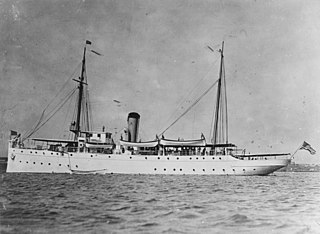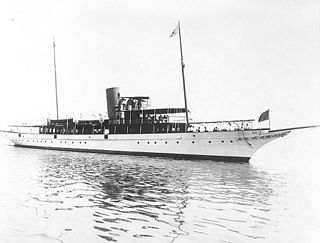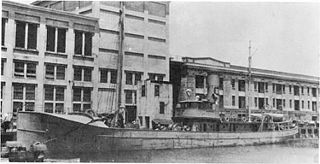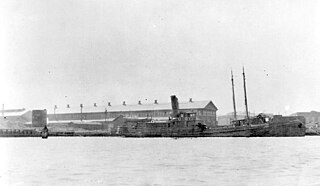
The second USS Conestoga (SP-1128/AT-54) was an ocean-going tug in the United States Navy. Commissioned in 1917, it disappeared in the Pacific Ocean in 1921. The fate of the vessel was a mystery until its wreck was positively identified in 2016.

USS Alcedo (SP-166) was a yacht in the United States Navy. She was the first American vessel lost in World War I.

USS Isabel (SP-521), later PY-10, was a yacht in commission in the United States Navy as a destroyer from 1917 to 1920 and as a patrol yacht from 1921 to 1946.

The auxiliary patrol vessel USS Yacona (SP-617) was built in 1898 in Scotland as a civilian steam yacht of the same name. Later, she was renamed Amélia as a survey yacht of the King of Portugal, before reverting to Yacona in 1901. She was acquired by the U.S. Navy in September 1917 and served until 1919 as a patrol vessel in the western Atlantic. In 1921 she was transferred to the Philippines as the governmental yacht Apo, serving until 1932.

USS Lykens (SP-876/AT-56) was a steam tugboat purchased from the Reading Company by the United States Navy in 1917. Because she was privately built, she was not of a ship class. She was the only U.S. Navy ship of this name.

USCGC Tampa (ex-Miami) was a Miami-class cutter that initially served in the U.S. Revenue Cutter Service, followed by service in the U.S. Coast Guard and the U.S. Navy. Tampa was used extensively on the International Ice Patrol and also during the Gasparilla Carnival at Tampa, Florida and other regattas as a patrol vessel. It was sunk with the highest American naval combat casualty loss in World War I.

An armed yacht was a yacht that was armed with weapons and was typically in the service of a navy. The word "yacht" was originally applied to small, fast and agile naval vessels suited to piracy and to employment by navies and coast guards against smugglers and pirates. Vessels of this type were adapted to racing by wealthy owners. The origin of civilian yachts as naval vessels, with their speed and maneuverability, made them useful for adaptation to their original function as patrol vessels. In the United States Navy armed yachts were typically private yachts expropriated for government use in times of war. Armed yachts served as patrol vessels during the Spanish–American War and the World Wars. In the latter conflicts, armed yachts were used as patrol vessels, convoy escorts, and in anti-submarine duties. In the United States, yachts were purchased from their owners with the owners given an option to repurchase their yacht at the close of hostilities.

The first USS Vedette (SP-163) was a commercial yacht built in 1899. At the outbreak of World War I, the yacht was leased by the United States Navy, and was used as a section patrol craft in the North Atlantic Ocean. She served honorably during the war, rescuing survivors at sea, and attacking a German U-boat. At war’s end, she was converted to her original configuration and returned to her owner, the railroad executive, financier, and philanthropist Frederick W. Vanderbilt (1856-1938) of New York City.

USS James (SP-429) — also known as USS W. T. James (SP-429) — was a steam trawler acquired by the United States Navy during World War I. She was converted into an armed minesweeper and assigned to the European Theater, where she performed varied tasks, including minesweeping, patrolling, and escorting of larger ships in convoy. In 1919, while returning to the United States, she was severely damaged in a storm off the French coast, and sank. Her crew were rescued.
The first USS Barnegat (SP-1232) was a commercial tugboat acquired by the U.S. Navy during World War I. She was armed with a 3-inch gun and sent to Brest, France, to perform towing services for Allied ships. Post-war, she returned to the United States, was decommissioned, and was subsequently used on the Delaware River by the U.S. Army Corps of Engineers.

USS Artemis (SP-593), launched as the steam yacht Cristina then upon sale the yacht was renamed Artemis. The yacht was purchased by the United States Navy during World War I and the name was retained. Artemis was armed with guns and depth charges and sent to Europe as a patrol craft to protect Allied ships from German submarines and other dangers. The patrol yacht was renamed Arcturus in 1918. Post-war she was returned to the United States and turned over to the United States Coast and Geodetic Survey. Later, again Artemis, the vessel was in civilian operation until burning and sinking in 1927.

USS Galatea (SP-714/YP-714) was a yacht acquired by the U.S. Navy during World War I. She was outfitted as an armed patrol craft and served in the North Atlantic Ocean. At war's end she was used as a receiving ship in Portsmouth, New Hampshire, for submariners before being sold in 1921.

USS Utowana (SP-951) – also known as USS Victorine (SP-951) -- was a fishing trawler acquired by the U.S. Navy during World War I. The Navy had planned to use her as a minesweeper based out of Kittery, Maine; however, Utowana spent most of her service time operating as an armed patrol craft, responsible for escorting Allied ships across the dangerous North Atlantic Ocean. She served through the war and the armistice before returning to the United States for decommissioning.

USS Goliah (SP-1494), also listed as ID-1494, was an armed tug that served in the United States Navy as a patrol vessel and tug from 1918 to 1919.
USS Wilbert A. Edwards (SP-315), sometimes called USS W. A. Edwards, was a United States Navy patrol vessel in commission from 1917 to 1919.

USS East Hampton (SP-556) was a United States Navy minesweeper, patrol vessel, and lightvessel in commission from 1917 to 1919.

USS Dreadnaught (ID-1951), later YT-534 and YNG-21, was a United States Navy tug that was in service from 1918 to 1944.

USS Arctic (SP-1158) was a wooden-hulled steam tug acquired by the US Navy during World War I. Arctic was briefly employed as a convoy escort during the war and later used to tow targets and transport ammunition. She was returned to commercial service in 1919.

USS Venetia (SP-431) was a large 589 gross ton steam yacht leased by the U.S. Navy during World War I. She was heavily armed with four 3-inch (76 mm) guns and depth charges, and was assigned duties of a patrol craft, escorting ships in convoy on the North Atlantic Ocean, and protecting those ships from German submarine attack. Venetia was awarded a "star of reward" for her antisubmarine work, and mounted the star on her stack. Post-war she was restored to her original civilian configuration, and was returned to her owner.

HMCS Wolf was an armed yacht of the Royal Canadian Navy during World War II that saw service on the British Columbia Coast of Canada. Constructed in 1915 as the yacht Wenowah, with the US entry into World War I, the vessel was taken into United States Navy service as USS Wenonah (SP-165) as a patrol ship. The vessel escorted convoys between the United States and Europe and between Gibraltar and Bizerte, Tunis and Genoa, Italy. After the war, Wenonah was loaned to the United States Coast and Geodetic Survey for three and a half years before being sold to private interests in 1928. In private ownership, the vessel was renamed at least twice, including Stranger and Blue Water.


















